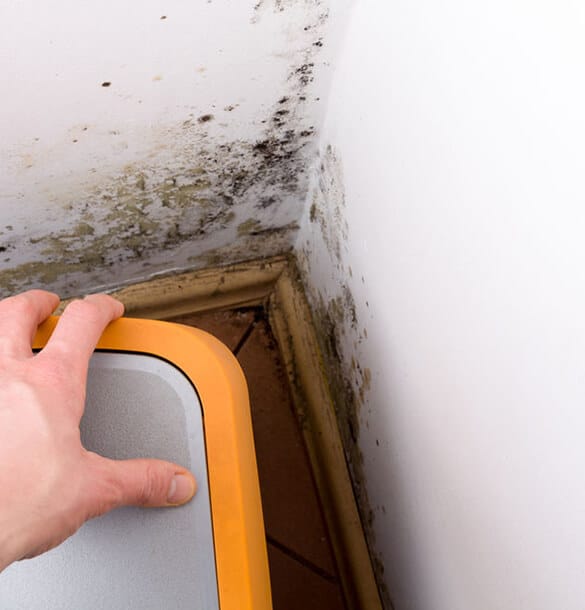Making Sure Post Remediation Verification Precision
Wiki Article
Specialist Tips for Message Mold And Mildew Remediation Success
In the realm of mold remediation, efficiently removing mold is just half the battle; real challenge exists in preventing its reappearance. Post-remediation initiatives play an essential function in ensuring a mold-free atmosphere in the long-term. By sticking to expert ideas and best techniques, individuals can guard their spaces versus mold and mildew revival and maintain a healthy and balanced indoor setting. It remains in this stage of the remediation process that interest to information and positive procedures really make a difference.
Screen Humidity Levels On A Regular Basis
After completing mold remediation treatments, keeping optimum humidity degrees is crucial to stop mold and mildew re-growth and make certain a healthy and balanced interior setting. High humidity levels above 60% create a helpful setting for mold to prosper, making routine keeping track of an aggressive measure to prevent any kind of future mold and mildew issues.In addition, developing a regular schedule for humidity checks, particularly in risky areas such as kitchens, basements, and restrooms, is an aggressive approach to mold avoidance. By continually checking humidity degrees, home owners can properly minimize the threat of mold reoccurrence and maintain a healthy interior environment post-remediation.
Conduct Thorough Inspections Post-Remediation
Adhering to the completion of mold and mildew remediation treatments, it is essential to conduct extensive examinations to validate the efficiency of the removal process. These post-remediation assessments are important in guaranteeing that the mold and mildew concern has been successfully addressed and that there is no reappearance or staying mold development. Examinations ought to be accomplished by certified professionals who have know-how in determining mold and analyzing interior air top quality.Throughout these inspections, numerous approaches such as aesthetic evaluations, air sampling, and surface area sampling may be used to thoroughly assess the remediated areas. Aesthetic assessments involve a comprehensive assessment of the premises to inspect for any type of visible indications of mold and mildew growth or water damages. Air tasting aids in identifying the airborne mold and mildew spore degrees, while surface area tasting can find mold and mildew particles on surface areas.
Implement Correct Air Flow Techniques
After ensuring the efficiency of the mold remediation procedure with thorough examinations, the following important action is to focus on implementing proper air flow techniques. Ample ventilation is vital in preventing mold and mildew reoccurrence by controlling moisture degrees and promoting air flow.
Proper air flow not just help in preventing mold and mildew development however also contributes to the overall wellness and convenience of owners. By making certain ample air flow throughout the property, you can lower the risk of mold and mildew regrowth and produce a much healthier living setting.

Use Mold-Resistant Materials for Repair Works
To boost the lasting efficiency of mold and mildew remediation efforts, including mold-resistant products for repair work is crucial in minimizing the threat of future mold growth. Mold-resistant products are made to hold up against dampness and hinder mold growth, making them an essential option for locations prone to dampness and humidity. When repairing areas affected by mold and mildew, using materials such as mold-resistant drywall, mold-resistant paints, and mold-resistant caulking can help protect against mold and mildew reoccurrence.Mold-resistant drywall is an exceptional alternative to standard drywall in areas like washrooms and cellars where moisture levels are higher. This kind of drywall has a special coating that withstands mold and mildew growth even when subjected to damp conditions. In addition, using mold-resistant paints consisting of antimicrobial representatives can further hinder mold growth on ceilings and walls.
In areas where wetness is typical, such as bathroom and kitchens, utilizing mold-resistant caulking around sinks, windows, and bathtubs can aid secure out water and protect against mold from holding in cracks and click over here now crevices. By purchasing these mold-resistant products during fixings post-remediation, you can substantially reduce the probability of future mold concerns and keep a much healthier interior setting.
Maintain Cleanliness and Address Water Issues
Making certain cleanliness and without delay resolving water problems are fundamental methods to support in safeguarding indoor spaces from mold and mildew reinfestation. After mold remediation, it is vital to preserve a tidy atmosphere to stop the regrowth of mold (After mold remediation). Routine cleansing, dusting, and vacuuming can aid get rid of any remaining mold and mildew spores and stop them from multiplying and working out. Furthermore, maintaining indoor areas dry and attending to any water concerns promptly is necessary in mold avoidance. Leaks, water breach, or high humidity levels can produce the perfect breeding place for mold, so it is essential to take care of any kind of water-related issues promptly.To maintain cleanliness, take into consideration using HEPA filters in vacuum cleaners and air purifiers to trap mold spores and stop their flow airborne. Guaranteeing appropriate air flow in locations prone to moisture accumulation, such as kitchens and shower rooms, can help keep humidity degrees in check. By remaining watchful regarding sanitation and dealing with water concerns quickly, you can effectively stop mold and mildew reinfestation and maintain a healthy and balanced interior environment.
Verdict

In the realm of mold removal, successfully removing mold is only half the battle; the true obstacle exists in stopping its reappearance. After finishing mold removal treatments, maintaining optimum moisture levels is important to stop mold and mildew re-growth and guarantee a healthy interior atmosphere. High moisture degrees above 60% develop a helpful environment for mold and mildew to grow, making normal keeping track of a positive measure to stop any type of future mold problems.
To improve the long-term performance of mold and mildew remediation efforts, incorporating mold-resistant products for repairs is crucial in alleviating the risk of future mold growth. After mold and mildew remediation, it is critical to maintain a tidy setting to prevent the regrowth of mold.
Report this wiki page